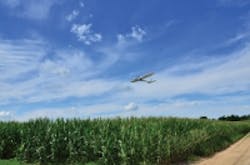UAV roundup May 2016: The latest in unmanned aerial vehicle news
In this edition of the unmanned aerial vehicle (UAV) roundup, we touch on a number of FAA-related items, including an aerospace forecast for the next 20 years, the raising of operating altitude for many UAVs, the development of an online registration process for small UAVs, as well as DARPA’s ‘Gremlins’ project, and aVision Systems Design magazine article highlighting some recent commercial UAV applications.
Vision takes flight in commercial unmanned aerial vehicles
Drones, also known as unmanned aerial vehicles (UAV) or unmanned aircraft systems (UAS) are commonly used in military applications. Advances in commercial uses of UASs in the United States, however, have been limited because of regulations on the use of airspace and privacy concerns. Now with new U.S. airspace policy, commercial markets are developing quickly as businesses are finding a diversity of applications.
Read about some of these in aMay 2016 Vision Systems Design article.
FAA issues aerospace forecast for next 20 years
The FAA released an aerospace forecast for 2016-2036, which includes analysis on unmanned aircraft systems (UAS), which “will be driven by a combination of improved regularly environment and underlying demand.”
In the forecast, the FAA predicts that sales of commercial UAS will increase from 600,000 in 2016 to 2.7 million in 2020, and that this forecast represents the high-end of the small UAS fleet and takes into account some assumptions regarding small UAS operating limitations over the next five years.
"The FAA's market forecast is further proof UAS hold tremendous promise," says AUVSI President and CEO Brian Wynne in anAUVSI release. "However, until the agency puts in place a regulatory framework, starting with finalizing the small UAS rule, this technology and its great potential will never fully be realized."
View theFAA forecast.
FAA raises operating altitude many UAVs, AUVSI responds
On March 29, the FAA announced that it raised the blanket altitude previously used for Section 333 exemption holders and government aircraft operators to 400 feet from 200 feet.
Later that day, the AUVSI responded.
"The FAA’s decision to raise the operating altitude of the blanket COA from 200 feet to 400 feet provides greater flexibility to those receiving FAA exemptions and makes it easier for more commercial UAS operators to access the skies. While regulation by exemption is not a long-term solution for the many industries waiting to operate UAS for commercial purposes, this is another positive step toward the overall integration of UAS into the NAS."
FAA launches online registration for small UAVs
The FAA has introduced a web-based registration process for owners for small UAVs used for commercial, public, or other non-model aircraft operations to register their aircraft. The fee for registration is only $5.
“Registration is an important tool to help use educate aircraft owners and safely integrate this exciting new technology into the same airspace as other aircraft operations,” says FAA Administrator Michael Huerta.
Read on.
Page 1 |Page 2
About the Author

James Carroll
Former VSD Editor James Carroll joined the team 2013. Carroll covered machine vision and imaging from numerous angles, including application stories, industry news, market updates, and new products. In addition to writing and editing articles, Carroll managed the Innovators Awards program and webcasts.

